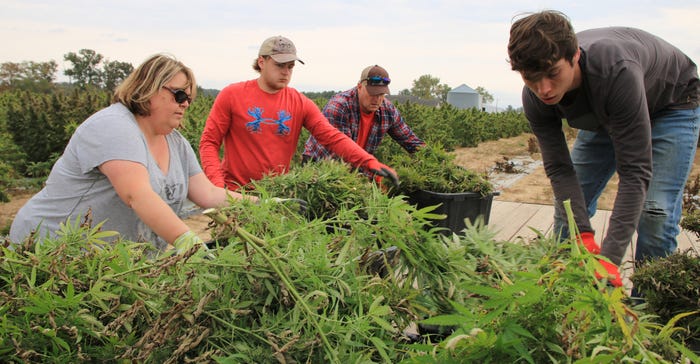
The Mosbys and Riders of Eldorado, Ill., took the 3 acres of hemp they harvested in 2019 down to 2 acres in 2020, planting less than half the crop they did the prior year. They say more hemp plants don’t mean more profit in a market where they lost more money than they made in 2019.
They took a different approach in 2020, and so did the rest of U.S. hemp farmers. While farmers harvested about 130,000 acres across the country last year, the Farm Service Agency estimates the 2020 hemp harvest will be closer to 65,000 acres.
Related: Why hemp farmers are betting on CBG
The Mosbys and Riders are using their remaining 2 acres to supply their higher-margin, consumer-direct sales and a growing product line at mrhemp-cbdil.com that includes calming tinctures, edibles and topicals.
Shawn Rider says the only way to turn a profit as an Illinois hemp producer of their size is to focus on higher-margin sales. He owns M.R. Hemp along with his wife, Michelle, and Rusty and Sheri Mosby.
Related: Develop your own brand to profit from hemp
New in 2020, they’re harvesting the top largest flower of the hemp plant and selling it as smokable flower, which can be used in hemp cigarettes, or hempettes.
Smokers don’t buy the hemp stems, small flowers and leaves that have low cannabidiol, or CBD. Instead, the Mosbys and Riders sell that biomass to a processor that concentrates it into shelf-stable crude oil. It’s used in making everything from dog treats to tinctures. Once in an air-tight container, it won’t spoil so long as storage temperatures remain under 70 degrees F.
Phillip Alberti, commercial ag educator with University of Illinois Extension, says growers around Illinois are looking at ways to increase profit margins, with several farms harvesting for both smokable flower and bulk processing off the same plants, just like the Mosbys and Riders.
“They’re taking the highest-quality, best portion of the plants and spending more time to dry, trim, cure and package them as smokable flower,” Alberti says. “We’re seeing more and more of this happen.”
Despite the decrease in acreage, the Riders and Mosbys are fetching about $150 a pound on smokable flower. This is better than the $3 to $8 a pound that processors are offering for biomass that includes the stems and leaves that are removed during smokable flower processing. Small stems and leaves still have CBD content useful for crude oil extraction.
“We’re still sitting on a lot of our crude oil from 2019,” Rider says. Crude oil has been selling for $200 a liter for months, $100 below their cost of production.
“We’re not selling it that low,” he adds.
New opportunity: Smokable flower
Farmers like the Mosbys and Riders are still going through a contract processor to convert their biomass harvest to crude oil, splitting the profits with the processor as the oil is sold or used to make high-margin products. The oil is strictly a commodity. But smokable flower gives them a new opportunity to grow their relatively small volume of sales. And others are catching on.
“Everyone who sells CBD products sell a smokable. To stay in the market and grow our business, this is what we have to do,” Rider says. “Plus, we can do the processing on the smokable flower side pretty much all by ourselves. We don’t have to split the profits with a processor.”
The Riders and Mosbys bought a machine trimmer that cuts the labor costs of trimming hemp flower down to colas, or flower buds, rich in the aromas that make smokable flower valuable.
RJ Hopp, hemp market director for commodity trading platform PanXchange, says demand is stable for smokable flower, and supply isn’t as saturated as biomass that goes to oil extraction.
“The oversupply of CBD from last year’s harvest is the biggest factor at play here on the supply side,” Hopp says.
He notes that regulatory uncertainty with the Food and Drug Administration on CBD products has negative impacts on demand.
Hopp believes better news is in sight for hemp producers. “In the long run, as the market and regulations mature, I do see CBD prices rising higher,” he adds.
The Mosbys and Riders agree. They’re working to increase their profitability while they wait for prices to pick up on the wholesale side.
“We’re selling one tincture at a time, so the retail-side money is slow coming. But we’ve got enough oil to keep our business going for several years,” Rider says, adding they may not grow any hemp next year to save on costs. But there’s another option.
“If this all turns out well on the smokable flower side, we may downsize some more and focus on that next year instead,” Rider concludes. “We’ll see where this takes us.”
About the Author(s)
You May Also Like




